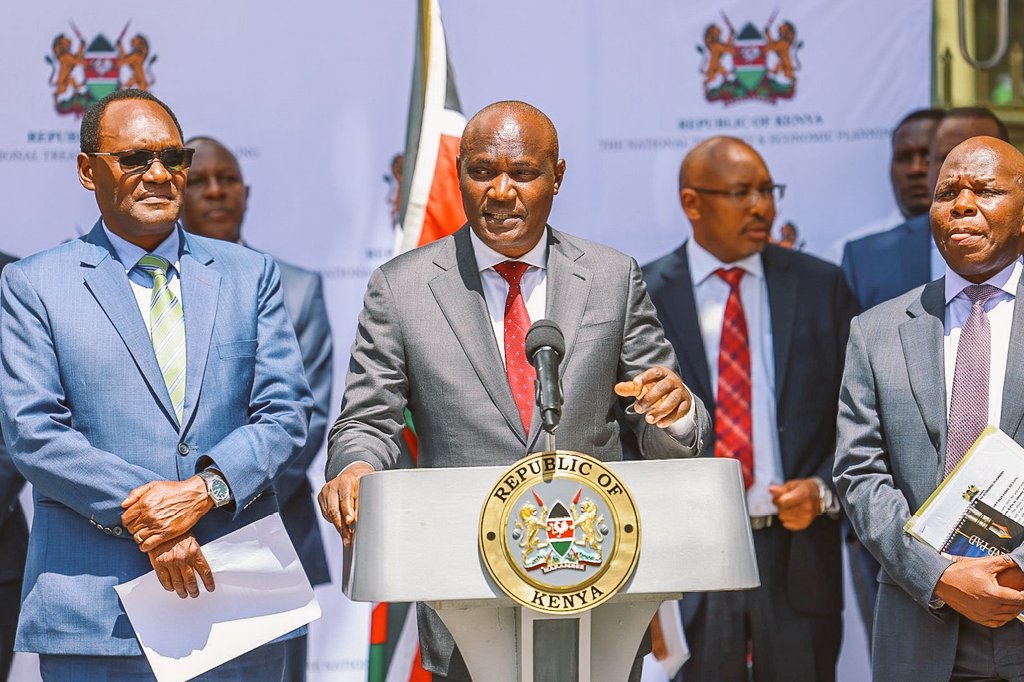Treasury under fire for using Sh2.67 trillion in domestic loans on recurrent spending

A report by the Auditor General reveals that the money raised between 2018 and 2023 largely went to cover routine exchequer releases and debt maturities, bypassing the intended development agenda.
The Treasury is under scrutiny for using Sh2.67 trillion in domestic loans to fund general government spending instead of earmarked development projects.
A report by the Auditor General reveals that the money raised between 2018 and 2023 largely went to cover routine exchequer releases and debt maturities, bypassing the intended development agenda.
More To Read
- Government eyes handing NTSA’s smart driving licence programme to private investor
- Government sets 14-day deadline to end student bursary delays nationwide
- Treasury: Kenya can no longer rely on taxes or borrowing for big infrastructure projects
- World Bank warns political interference weakening Kenya’s state-owned enterprises
- Treasury CS John Mbadi defends ballooning State House budget
- Ndindi Nyoro questions government’s decision to sell 15 per cent Safaricom stake
According to the performance audit on the management of cash and domestic debt, the government borrowed Sh2.97 trillion through Treasury bonds between July 2018 and June 2023. The Office of the Auditor General notes that despite fiscal rules requiring borrowing to support development, the Treasury has been operating without a framework to ensure that proceeds from domestic loans are ringfenced for that purpose, even as public debt has surpassed Sh12 trillion.
Auditor General Nancy Gathungu states that “out of this amount, Sh2.67 trillion was transferred to the Consolidated Fund Services (CFS) account, of which Sh558.87 billion was utilised to settle maturing domestic debt and the remaining balance of Sh2.1 trillion funded exchequer releases to Ministries, Departments and Agencies.”
However, the audit report shows that the remaining Sh300 billion, which was not deposited into the Consolidated Fund, could not be accounted for, with the findings giving no indication of how it was used.
While the Auditor General faults the Treasury for using proceeds from bond sales to meet debt obligations, the Treasury defended its actions, insisting that repayments are a first charge against the Consolidated Fund.
Gathungu, however, points out that mixing bond proceeds with other cash inflows, including tax revenues, once deposited into the Consolidated Fund, made it impossible to determine their specific utilisation.
“Because of the fungibility of money, the moneys were used to fund priority exchequer requests instead of lying idle in the Treasury bonds accounts and provided that at the end of the financial year the budget was fully funded, then there should be no problem,” she said.
“As a result, the audit could not verify what specific projects the Treasury Bonds proceed were expended on.”
The report also highlights the absence of a mechanism to ringfence projects to be financed through infrastructure bonds. It notes that the government has continued to float such bonds without detailing the specific projects targeted for funding.
Gathungu warns that this continued non-compliance with fiscal principles risks eroding investor confidence and undermining the development of the domestic securities market.
“Review of a number of Infrastructure Bond prospectuses indicates the purpose of these bonds to be very general and not specific to a particular infrastructure project, thereby unable to confirm the utilisation of the treasury bonds proceeds,” she said.
The Public Finance Management Act of 2012 requires the Treasury to ensure that government borrowings support development spending, while short-term borrowings such as overdrafts are reserved for managing cash flows.
The audit comes against a backdrop of a growing public debt load, which has risen to 67.3 per cent of Gross Domestic Product (GDP). Current data shows domestic debt stands at Sh6.66 trillion, equivalent to 37.2 per cent of GDP, while external debt is at Sh5.39 trillion, representing 30.1 per cent of GDP.
The country’s overall debt climbed by Sh1.26 trillion over the year to reach Sh10.8 trillion in September 2024. During this period, the debt-to-GDP ratio edged up from 66.5 per cent to 67.3 per cent, suggesting that nominal GDP growth was almost matching the rate of borrowing.
New figures indicate that Kenya’s debt stock grew by at least Sh250 billion between June and September, driven mainly by a Sh340 billion uptick in domestic borrowing. Over the same quarter, external debt dropped by about Sh80 billion.
This marks a clear shift in the government’s financing strategy, aligning with President William Ruto’s pledge to scale down reliance on external loans, especially those that expose the economy to foreign exchange volatility.
Kenya’s pivot toward domestic borrowing accelerated in the 2022/23 fiscal year when the country confronted a Sh2 billion Eurobond maturity amid soaring global interest rates, tight liquidity conditions and a weakening shilling.
Top Stories Today












































